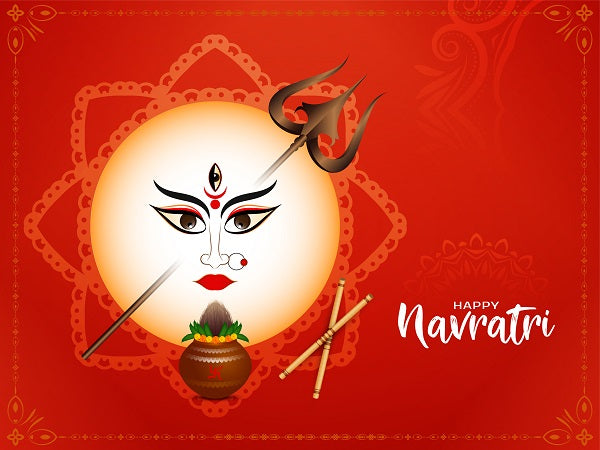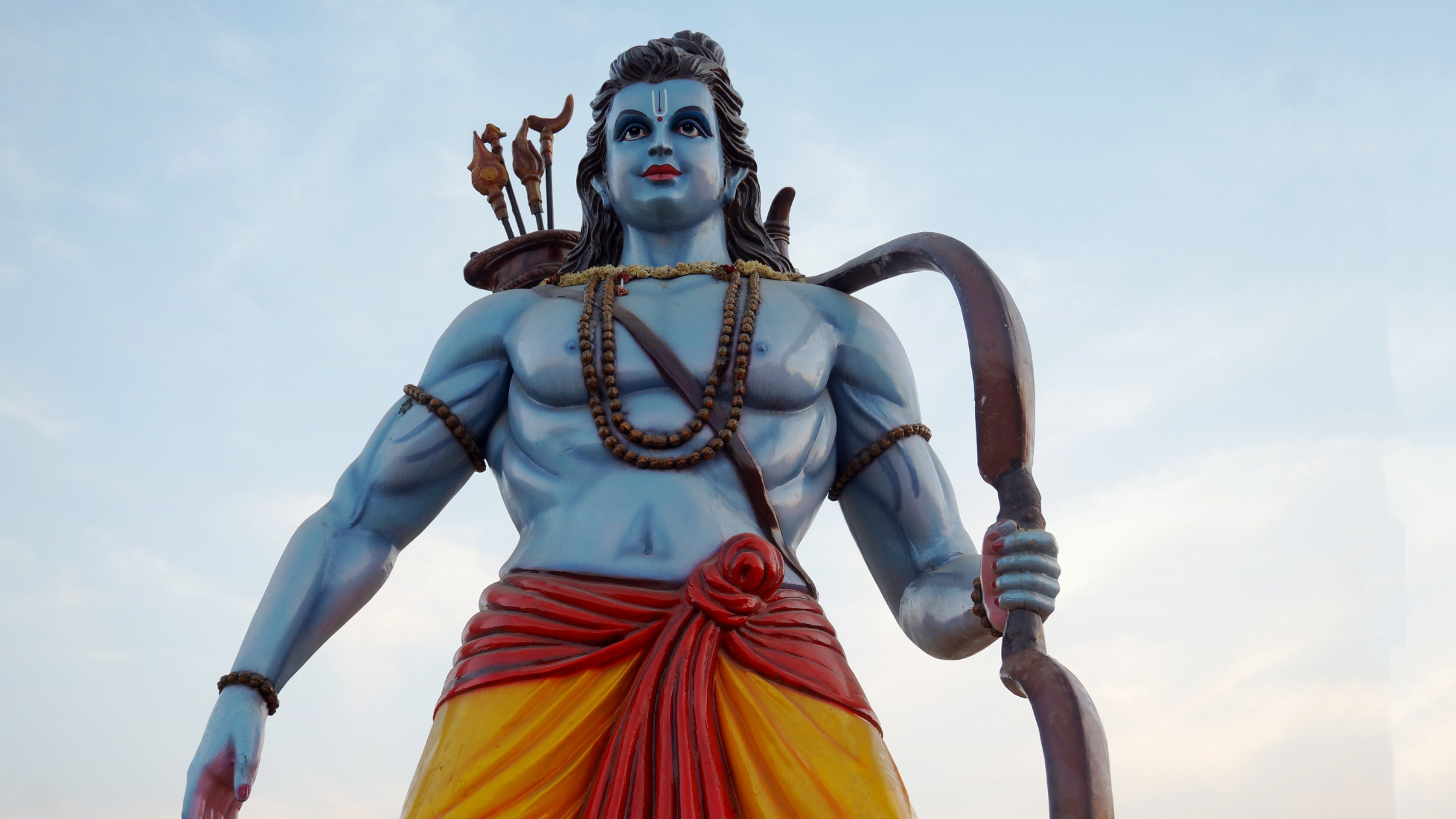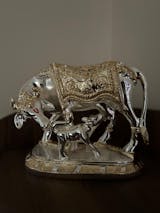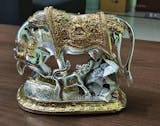Goddess Durga is a powerful deity revered across India. Durga Puja celebrates the power and ultimate triumph of good over evil, with the Goddess slaying the shape-shifting rakshasa or buffalo demon Mahishasura. This ten-day festival is also a celebration of the divine feminine or Shakti and is the grandest among all Hindu festivals, one that holds a special place in the hearts of millions.
In some parts, the festival is also called Navaratri, or nine nights, as Goddess Durga is worshipped during these days till she departs for her heavenly abode on the tenth day. Though Durga Puja is celebrated across the country and in Nepal (where it is called Dasain), no place can surpass or even hope to be close to the celebrations we witness in West Bengal, where the festival is called Durgotsava or Sharodotsav. Words would fail to describe the pomp and extravaganza in Bengal during the Pujas.
Before we look into the history and importance of Durga Puja, let’s find out when Durga Puja 2023 falls this year. The nine-day Sharadiya Navaratri starts after Sarva Pitru Amavasya, or the 16 days Hindus spend remembering their departed loved ones. Hence, Navaratri 2023 commences on October 15. Durga Puja starts on the sixth day of the month of Ashwin or Shukla Paksha and ends on October 24, the tenth day, also called Vijayadasami. The first day of this festival is when Goddess Durga arrives on Earth and is called Mahalaya. Vijayadasami is when the celebrations climax, with families and relatives converging dressed smartly and anew, merrymaking over sumptuous feasts. The family's eldest member blesses the younger ones with a long life, health, and happiness till they all meet again the following year.
So for this year, the Durga Pooja dates are as follows:
- October 15 - Mahalaya
- October 20 - Shukla Paksha
- October 24 - Vijayadasami
On the tenth and final day, Goddess Durga departs for her heavenly abode amidst much rejoicing and festivity. Giant idols of the Goddess adorned in richly coloured sarees and jewellery are carried reverentially from puja pandals and taken to rivers in huge processions for immersion. People pray to the Goddess for her blessings and invite her again the following year for yet another round of celebrations.
The history, significance, and importance of Durga Puja
It is important to explore the rich history behind Durga Puja to understand the meaning of this festival. The Durga Puja history is believed to go back to at least the 16th century when the festival and its celebrations were limited to royalty and wealthy families. Even so, manuscripts from the 14th century have been discovered that provide guidelines for Durga Puja. Again, some scholars estimate the period of origin around 400 to 600 CE, citing the mention of “Durga” in religious texts.
However, the word “Durga” appears even in Vedic texts (Atharvaveda), while Yudhishthira and Arjuna have invoked hymns to Goddess Durga in the Mahabharata. The Devi Mahatmya, a key text recited during Durga Puja, dates back thousands of years. There may be no consensus on the exact date. Still, one thing is certain: the festival has become of immense importance to all echelons of society today in India and in regions where Hinduism flourishes, especially in Nepal.
Most importantly, the significance of Durga Puja goes far beyond religious beliefs as it unites communities and promotes unity and harmony among people from diverse backgrounds. Families use the occasion to meet one another, offer prayers to Goddess Durga, exchange gifts, relive cultural performances and rituals, seek the blessings of elders, and partake in delicious food.
Durga Puja’s importance underscores one universal truth—that evil forces can never overcome the good ones. To drive home the essence of this statement, the significance of Durga Puja has been wrapped around in mythology. There was a rakshasa named Mahishasura who, through intense penance and devotion, had received a boon from Lord Brahma of being invincible. But this power got into the demon’s head, and he began to cause mayhem on Earth, threatening to kill all the gods, including mankind. This was when the Trinity, comprising Brahma, Vishnu, and Shiva, created Goddess Durga and gave her immense power to defeat Mahishasura.
The Goddess they created was a fierce warrior with powerful weapons in her multiple hands. A fierce battle that lasted for nine days and nights raged between Goddess Durga and Mahishasura. On the tenth day, known as Vijayadashami or Dussehra, the Goddess vanquished the demon, and there were celebrations in heaven and Earth rejoicing in the victory of good over evil. Thus, the Durga Puja significance is to encourage mankind never to get swept away by power and position and become arrogant and wicked.
Durga Puja traditions and rituals
The worship of Goddess Durga takes place amidst elaborate rituals and traditions, with each region in the country having its own way of celebrating the festival. Preparations for the festival begin early on, with craftsmen moulding giant-size idols of Goddess Durga using clay and hay. They also create her four associates: Ganesh (God of wisdom), Lakshmi (Goddess of wealth), Saraswati (Goddess of knowledge), and Karthik (God of war).
Mahalaya, or the first day, heralds the beginning of Devi Paksha, or the period when the Goddess graces humanity with her presence. The sixth day, or Shasthi, marks the start of the actual puja when idols of Goddess Durga are installed in pandals for devotees to take darshan and partake of prasad. In some regions, particularly in Nepal, girls who have not yet reached puberty are worshipped as Kumari or the manifestation of the Goddess.
These Durga Puja rituals are symbolic of the nature of the Divine—pure and innocent. Of the Durga Puja traditions in some other cultures, another significant one happens on Vijayadasami, when married women apply vermilion on each other’s foreheads to signify marital bliss. They also apply vermilion (sindoor) on the Goddess’ idol. Again, to showcase the richness of their culture, people dress in traditional attire and participate in processions welcoming the Goddess. The Phoolpati procession on Saptami (the seventh day) fuses nine types of flowers and plants. It is kept in the puja room, signifying another tradition among the many Durga Puja traditions.
Again, in places such as Bengal, Assam, and Odisha, Durga Puja celebrations take a different trajectory, with local clubs and religious organisations installing pandals marking different themes. Competitions for pandal assembly are held yearly, wherein clubs borrow themes from various fields and create impressive replicas. For instance, some may borrow the theme of a popular movie released that year, a significant structure (a landmark bridge), and so on. During Durga Pujo 2023, we will surely see some replicas of India’s Chandrayaan - 3 lunar exploration mission showcased by some pandals!

Gold Coated Durga Mata | 5 inch
Durga Pooja Shubh Muhurat
In 2023, the Durga Pooja Shubh Muhurat (auspicious timing) starts at 11:44 p.m. on October 14 and concludes at 12:32 p.m. on October 15. This is the period for the Kalash Sthapana or Ghatasthapana, “kalash” or “ghata” being a metal pot, considered a container of fertility. It signifies the earth and the womb that nurtures life. The mango leaves in the kalash represent Kama (god of love), symbolising the pleasure aspect of fertility. The coconut stands for power and prosperity. Navratri is incomplete without the Kalash Sthapana, which is believed to bring good luck and positivity. Hence, the Durga Pooja 2023 start and end dates are from October 15 through October 24. Mahalaya is on October 15, Shasthi Tithi (sixth day) on October 20 (when the actual puja starts), and Vijayadasami, or the tenth and final day, is on October 24.

Gold Coated Durga Mata Idol | 8 inch
Happy Durga Pooja - Shubho Dashami!
Durga Puja celebrates feminine energy, or Shakti, as she is referred to in Indian culture. The occasion is full of festivities and merrymaking but very symbolic at the same time. First, it teaches us to respect the female as she nurtures life. The respect accorded to women in Indian society and culture is clearly evident from this festival.
We should also understand that Durga Puja goes beyond religious barriers and is an occasion to celebrate life, be grateful, and love each other. Among the many symbolisms associated with Durga Puja, one worth noting is that evil can never triumph over good. Man gets lost in the illusion of life, assuming the temporary for the permanent. He runs after worldly power, pleasures, and material gains, forgetting his innate nature of goodness. Selfishness is the root of all vice, and time and again, mankind needs a reminder from the divine that pride and arrogance will only lead to his ultimate downfall.
So, let us all celebrate Durga Pujo 2023 with feelings of gratitude, kindness, and love towards all beings, for this ten-day festival is an occasion to thank the Almighty for everything we have and rejoice as part of one huge family called humanity.





